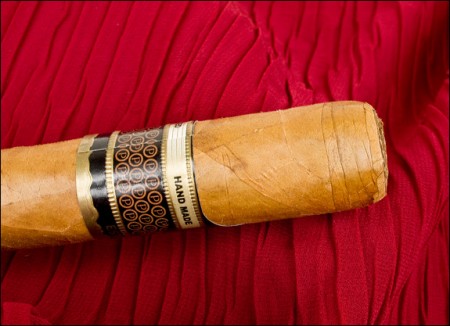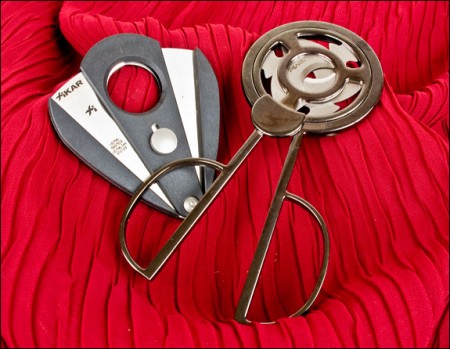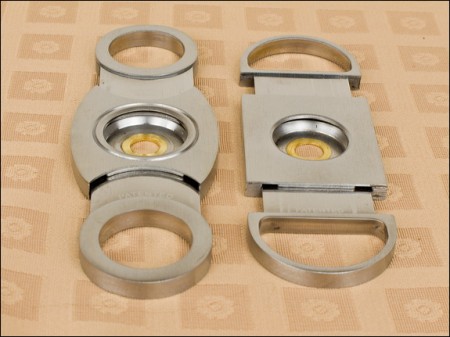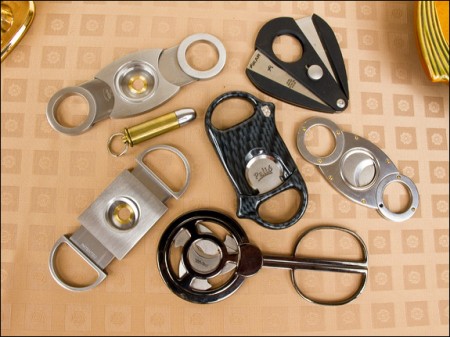The late, great, comedian George Carlin once said that life was about acquiring “stuff”. This is especially true for cigar smokers. To us, the need for “stuff” seems endless. Aside from continually buying cigars, we also need humidors, ashtrays, lighters, hygrometers, humidifiers, and above all, cigar cutters. Unless we want to look like Clint Eastwood in The Good, the Bad, and the Ugly, it’s best not to bite off the ends of our cigars. Instead, we more civilized folks prefer using cigar cutters; instruments designed to do one thing, and one thing only: to cut off the ends our cigars. Being of singular purpose, these precision instruments generally work well. But not all cigar cutters are created equal. Some are actually punches, and puncture rather than cut the cigar cap. Others look like small pruning shears, and use a scissor action. And then there is the “V” cutter, slicing a groove into the cap. There is no “correct” way to cut a cigar, and it’s simply a matter of personal preference. However, this article will focus on the most popular kind, the guillotine cutter. And like its name implies, its design dates back to Marie Antionette.
On the surface, one might think that all guillotine cutters would perform about the same. Yet over the years, I’ve gone through many guillotine cutters, and found that the subtle differences between them can make a big difference. There are a few factors that make one cutter better than another; let’s talk about them one at a time:
Sharpness: This seems like it would be obvious. After all, a cigar cutter is a knife, and the sharper the blade, the better the knife. But I’ve seen some scissor type cigar cutters that were dull beyond usefulness. These would squash, rather than cut a cigar. But generally, all guillotine cutters, even the promotional freebies, have sharp blades. Here the playing field is pretty level.
One blade or two: Guillotine cutters fall into two categories: single or double blade. It has been my experience that the double blade cutters work better. Even with a razor-sharp cutting edge, a single blade cutter tends to squash the cigar as it cuts. With the introduction of a second blade, a cutter’s performance greatly improves. There is less compression when two blades work at opposing angles, and less compression means better draw. Common sense would assume that a two-blade cutter would be more expensive than one with a single blade. But that’s not true. The single blade Siglo Seki Cutter retails for $141.00, while the majority of twin blade cutters are under $20.00. One cutter worth mentioning is the Palio cutter ($44.95 retail). Although it’s got two ultra-sharp blades, its design acts more like a single blade cutter. Each blade is fixed to the body of the instrument; not “free floating” like some quillotine cutters. This design compresses the cap against the oversized body of the cutter. Cigars cut with the Palio seemed to have a slightly diminished draw compared to other guillotine designs.
Design: Getting the perfect guillotine cut can be difficult. Too deep a cut and the cap might unravel; too shallow and the cap can feel rough on the lips. The best cut is one that removes a portion of the rounded cap, but leaves the wrappings intact. This can be accomplished with good eyesight and hand-eye coordination. But in dim light, or questionable dexterity, the perfect cut can be a difficult task. These days there is no reason to even think about such trifles. Cubancrafters.com offers a number of cigar cutters that make things a whole lot easier. Their Perfect Cutters have a closed end that serves to measure the perfect cutting depth. Simply place the cap against the stopper and make the cut. Voila! A perfectly cut cigar! If you’re smoking a figurado, the Perfect Cutter has a hole to accommodate its pointed cap.
Cubancrafters offers a number of different styles of Perfect Cutters. I’ve discovered that the model with the square shape gives a slightly shallower cut than the others. All the Perfect Cutters I’ve tried performed well, but beware of plastic cutters with this design. They tend to flex while cutting, and don’t perform as well as the rigid metal devices.
Exotic designs: There is one unusual style of guillotine cutter that, on the surface seems like a good design. This is the Revolution cutter. It’s got three blades that slice the cap in a rotary fashion. But this cutter has issues. First is its scissor design. This prevents the blades from having good downward pressure while making the cut. Secondly, tobacco tends to get jammed between the rotary blades, causing the cutter to seize. And thirdly, the original Cubancrafters models had poorly welded handles. This led to failure after only limited use. Of the three Revolution cutters I’ve owned, all had failed. The Revolution design appears to be a copy of the expensive Tsubota Pearl cutter. I have both versions of this, and neither of them gets much use. They reside in the drawer with the other cigar-related “junk” I’ve collected over the years.
Teardrop cutters: These cutters are a relatively new design. They are similar in action to the standard two-blade cutter, but have a clamshell type mechanism. The cutter is opened with a spring-loaded button, and you cut the cigar by squeezing two handles together. In theory this should work well, but I find these cutters a bit clumsy to use. Plus it is hard to make a precision cut because the device doesn’t fit comfortably in the hand. It is also more difficult to cut multiple cigars quickly; they lock after each cut.
Recently, a number of new, innovative cigar cutters have hit the market. Cigar Aficionado has a great article called Cigar Toy. It describes all sorts of cigar cutters, and is a fun read.
And the winner is… After many years of trying all sorts of gadgets, I find myself relying primarily on the Cubancrafters Perfect Cutter. It gives the perfect cut, each and every time. And no matter how dark the lighting, or how intoxicated the smoker, cutting the cigar doesn’t get any easier or better. And at $14.99, it’s an investment whose value is far beyond its cost. And Cubancrafters has a lifetime guarantee. If it ever gets dull or breaks, send it back for a free replacement.
When it comes to cigar cutters, it’s not necessary to reinvent the wheel. A simple design dating back 200 years still works best. And being one of the least expensive options, the Perfect guillotine cutter is a great way to start a cigar!





I too have used many different cutters, from simple to exotic, but to me, the best , hands down, is the cigar punch. Fancy or simple as long as it’s sharp, it’s my only choice now.
Have been lighting and smoking cigars for some 35 years now. The last 14 years using the same Xicar cutter, I guess after enough cuts practice makes perfect? 🙂 I have sent it back to have the blades sharpened.
While away I have enjoyed the Xixar V cut for 46-52 ring gauge cigars, nice change in pace 🙂
Hi Joe! Yes I understand what you mean but I’ve never noticed a problem with such compression – especially compared to the one blade types. Meanwhile all those “free floating” types, even expensive ones, are loose and wobble around (I have several) while the Palio is tight and travels smoothly with no wobble. I like that about it. Feels like a precision instrument compared to the others. But I do get what you are saying.
Mathew, thanks for reading this article. Yes, the Palio has two opposing blades, but each blade is attached to the thick plastic housing. Because of this, fat cigars get compressed more with the Palio design, than with what I refer to as “free floating” (Palio has two sections while the other has three). In the latter, the blades penetrate the cigar deeper, without impacting any obstruction. Look at both cutters and I think you’ll see what I’m trying to say. It’s a bit hard to describe.
I think you misunderstand how the Palio works. If you look at one side it looks like one blade slides and the other is fixed. Flip it over and voila! The original sliding side looks fixed and the opposite side is the slider! The fact is both sides slide across one another!
Interesting review, and as Robustojoe states, it is essentially a matter of personal preference.
Of my collection of cutters, my Xikar “teardrop – clamshell” cutter is my favourite. The fact that it locks after each cut is of little consequence – slide the button and it is ready again – in less than one second. Ergonomically? No less difficult than any other guillotine cutter I have tried.
That aside, I find that all cutters squeeze the cigar to some degree before executing the cut, the amount of squeeze inflicted depending upon the sharpness/bluntness of the blade(s). By the way, yes, the pun was intended.
I will need to acquire a Cubancrafters Perfect Cutter, if for no other reason than to experience the sharpness of the “self sharpening blades”. The closed section is no more than an evolution of the old tip of lying your guillotine cutter on a flat surface, dropping your stogie between the blades, and squeezing. Voila, a perfect cut! I do like the idea, however, of the small hole to accommodate the cutting of figurados.
Cheers
PC
Great cutter commentary! I’ve got most of these (and quite a few others) and they are spot on. My favorite is the SAK (Swiss Army Knife) with curved scissors because of sharpness and control.
Ah. For some reason I didn’t make the connection. So as far as I can see we’re on the same wavelength regarding the Xikars.
I agree that the Xikar design is hard to use. I mention this in the article and refer to this design as “clamshell”
I find their overall ergonomics inferior to regular cutters (including Palio), I had some missed cuts because of this and ended up giving away the cutter. I have rather small hands, perhaps that’s the reason.
What’s your issue with his Xikar cutters?
Thank you Robustojoe for the in-depth post. I find myself only using a punch for the last couple of years, except for torpedos.
You don’t mention Xikar cutters, what’s your experience with this popular brand? Personally I’m not a big fan.